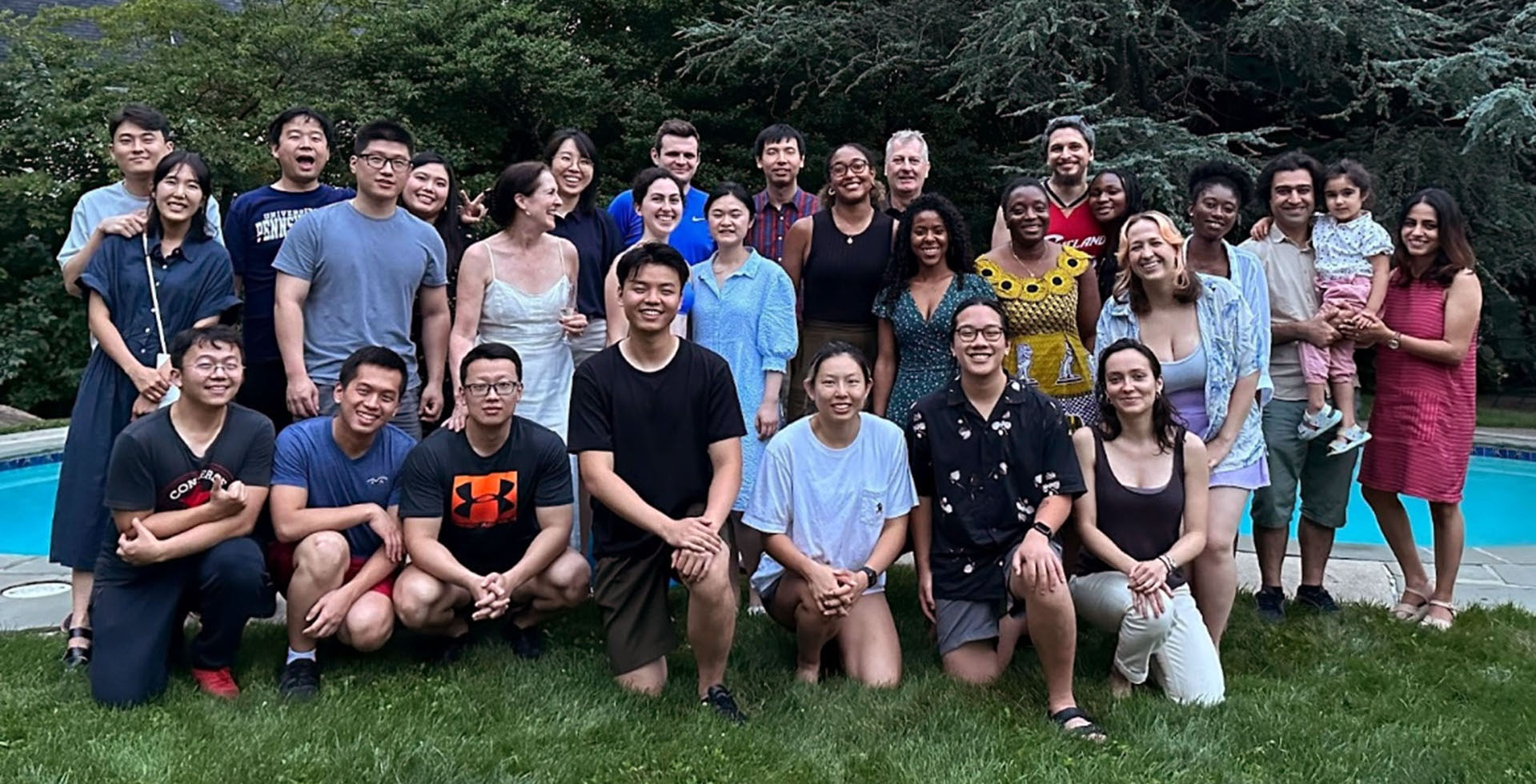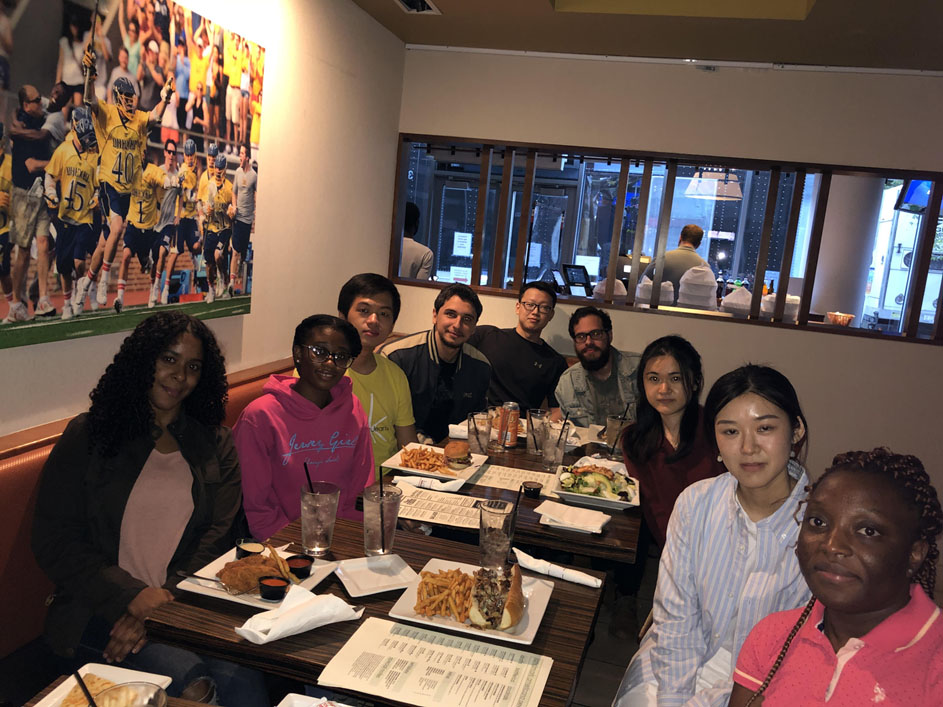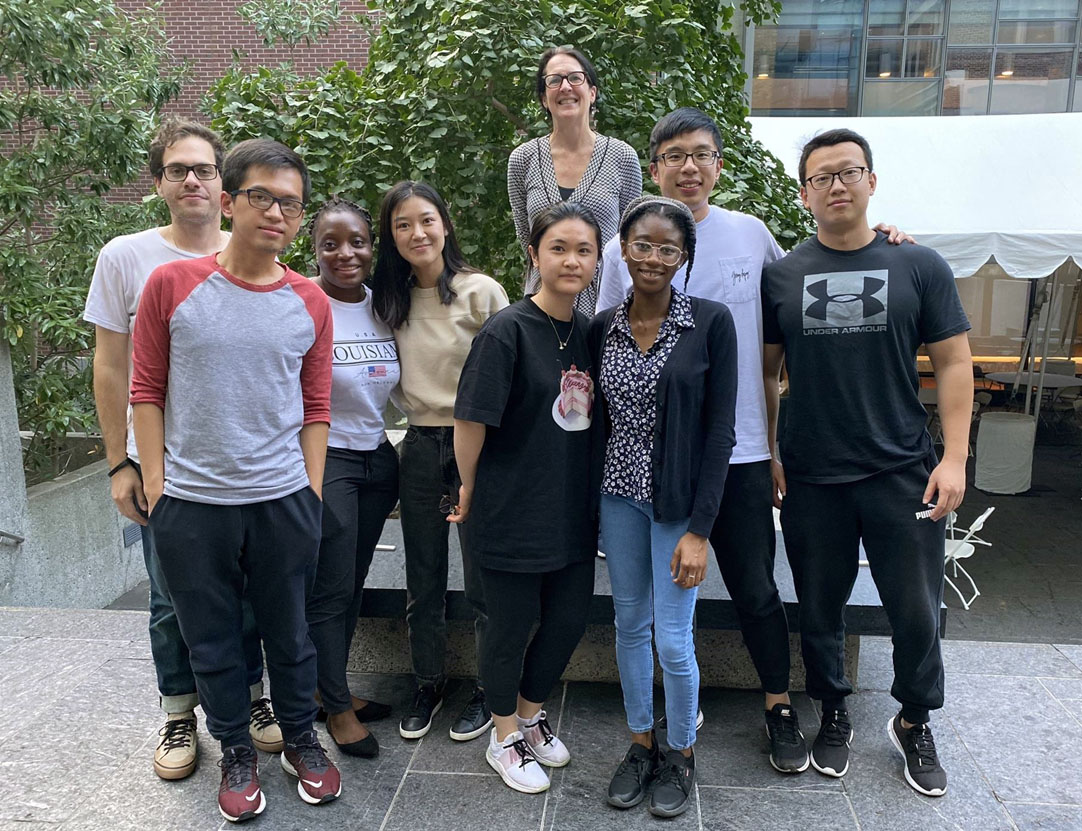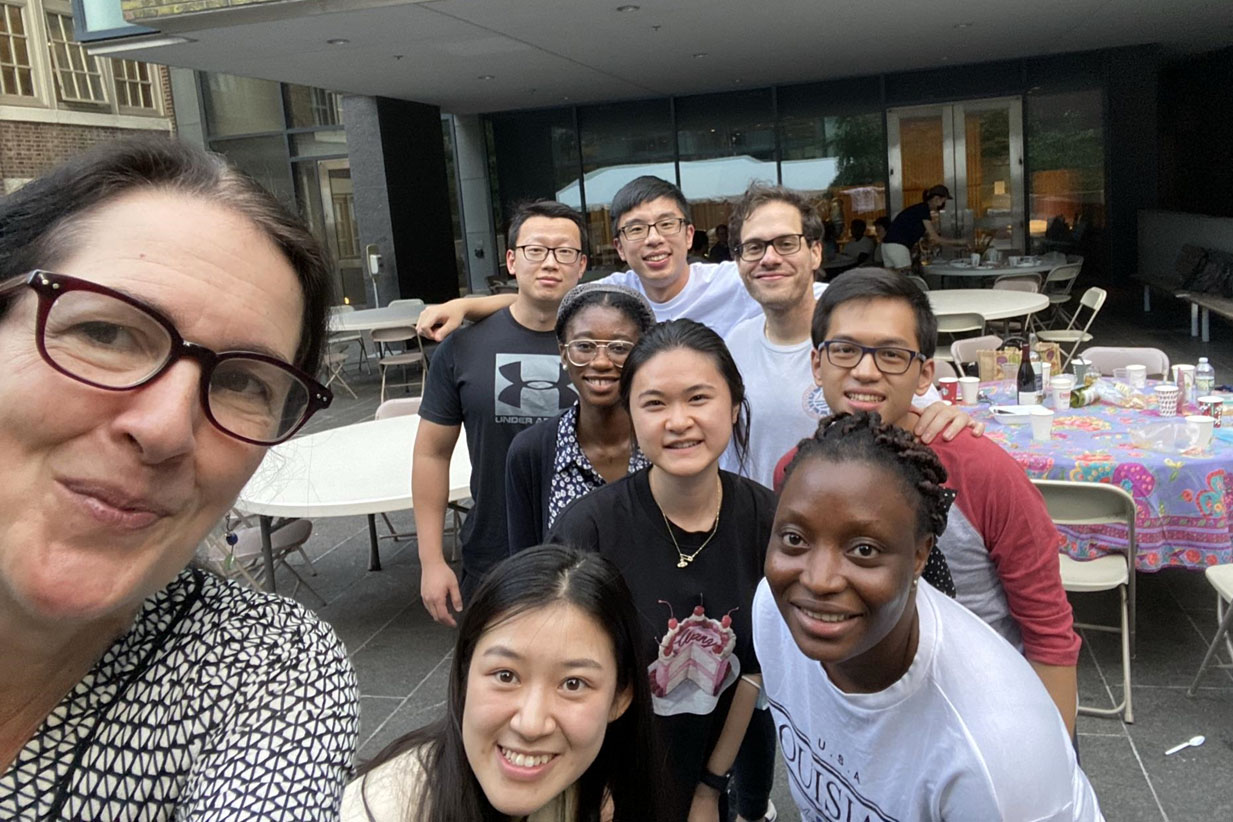Summer 2023

December 2022

Recent Group Photos








Graduate student Iris Liu, in collaboration with Denise Wong from Professor Vijay Kumar’s lab, combine strategies for passive particle assembly in soft matter with robotics to develop new means of controlled interaction.
Source:
https://www.youtube.com/watch?v=5qOWN9MZKjo
Graduate student Nate Bade revealed that two populations of actin stress fibers align in distinct directions when cells experience a negative Gaussian curvature surface. Here, a mouse embryonic fibroblast has been stained for F-actin (grey) after being cultured on a curved sphere-with-skirt surface coated with fibronectin (green). Scale bar is 20 µm.
Source:
https://www.cell.com/biophysj/fulltext/S0006-3495(18)30201-7
Cells migrate in a unique pattern in response to a complex surface with non-zero Gaussian curvature. By imaging mouse embryonic fibroblasts expressing Lifeact-GFP, Nate Bade showed that these cells avoid the positive Gaussian curvature portion of a sphere-with-skirt surface. Instead, these cells migrate around the feature on the negative Gaussian curvature skirt. Red circles indicate lines of constant surface height separated by 18 µm in height. The actin cytoskeleton is revealed by the Lifeact-GFP signal shown in grey. Total duration: 11.3 hr.
Graduate student Lisa Tran submitted a video of water droplets forming fingerprint-like patterns when surrounded by cholesteric liquid crystals to the Nikon Small World Competition and ended up winning fifth place.
Source:
Lisa Tran, Kathleen J. Stebe, Randall Kamien
Graduate student Yimin Luo gave a Penn iTalk (interdisciplinary talk) to a broad audience of various subjects in the engineering school, on her work of directed colloidal assembly in confined nematic liquid crystal.
Source:
Yimin Luo, Francesca Serra, Kathleen J. Stebe
http://pennitalks.blogspot.com/
A strain of bacteria formed an interfacial film on this hexadecane drop injected into the respective bacteria suspension. Upon compression of the drop by withdrawing oil, the interfacial film showed signs of elasticity and the ability to support shear stresses.
Source:
Liana Vaccari, Daniel Allan, Nima Sharifi-Mood, Aayush Singh, Robert Leheny, Kathleen Stebe
http://pubs.rsc.org/en/Content/ArticleLanding/2015/SM/c5sm00696a#!divAbstract
On air water interface, wavy particles assemble end to end. However, particles with different wavelengths repel each other in the near field, leading to measurable equilibrium separation.
Source: Near field capillary repulsion. Lu Yao, Lorenzo Botto, Marcello Cavallaro, Jr, Blake J. Bleier, Valeria Garbin and Kathleen J. Stebe
http://pubs.rsc.org/en/content/articlepdf/2013/sm/c2sm27020j
A pair of cylinders, L=21 micron and R=3.5 micron, interact on air-water interface. By capillarity, the particles attract each other in mirror alignment until they are quite close; then they rapidly co-rotate to end-to-end alignment.
Source: Orientation and Self-Assembly of Cylindrical Particles by Anisotropic Capillary Interactions. Eric P. Lewandowski, Marcello Cavallaro, Jr., Lorenzo Botto, Jorge C. Bernate, Valeria Garbin, and Kathleen J. Stebe
Link: http://pubs.acs.org/doi/abs/10.1021/la1012632
Drop retraction over unstable thin films-intermediate drop II & III: rim propagation towards the bulk of the drop and termination with a drop recovery regime. Tanner's law approximates the dynamics of the apparent contact line and the disjoining pressure gradients are isolated near the contact line.
Source: "Spreading and retraction as a function of drop size" Moniraj Ghosh, Kathleen J. Stebe
Link: http://www.sciencedirect.com/science/article/pii/S0001868610001454
Drop retraction over unstable thin films-intermediate drop I: rim formation via spinodal instability. The film thins adjacent to the contact line, simultaneously driving liquid into the parent drop to form a rim and forcing the formation of a daughter drop. The duration of this regime can be characterized in terms of the timescale for the instability, and the scale of the rim can be characterized in terms of upper and lower spinodal film thicknesses.
Source: "Spreading and retraction as a function of drop size" Moniraj Ghosh, Kathleen J. Stebe
Link: http://www.sciencedirect.com/science/article/pii/S0001868610001454
Drop retraction over unstable thin films-nanodrop: thin film dewetting and ripening dominated dynamics. Disjoining pressure gradient permeates inside drop (no Tanner's law regime) and the distance between daughter drops can be predicted by linear Stability Analysis.
Source: "Spreading and retraction as a function of drop size" Moniraj Ghosh, Kathleen J. Stebe
Link: http://www.sciencedirect.com/science/article/pii/S0001868610001454
Colloidal particles migrate towards the edge of the post induced by bulk topological defects.
Source: "Exploiting imperfections in the bulk to direct assembly of surface colloids", Marcello Cavallaro, Jr., Mohamed A. Gharbi, Daniel A. Beller, Simon Čopar, Zheng Shi, Tobias Baumgart, Shu Yang, Randall D. Kamien, and Kathleen J. Stebe
Repeated heating and cooling of the nematics causes disapparence and reappearance of the defect ring around the pillar. The bulk defect rings arise due to the ordering of the nematics.
Source: Source: "Exploiting imperfections in the bulk to direct assembly of surface colloids", Marcello Cavallaro, Jr., Mohamed A. Gharbi, Daniel A. Beller, Simon Čopar, Zheng Shi, Tobias Baumgart, Shu Yang, Randall D. Kamien, and Kathleen J. Stebe
At very high surface coverage, highly-ordered hexagonal structure forms due to the mutual repulsion among colloids. Migration of colloidal particles is induced by bulk topological defects.
Source: "Exploiting imperfections in the bulk to direct assembly of surface colloids", Marcello Cavallaro, Jr., Mohamed A. Gharbi, Daniel A. Beller, Simon Čopar, Zheng Shi, Tobias Baumgart, Shu Yang, Randall D. Kamien, and Kathleen J. Stebe
A single microbullet rotates due to an applied electrical field in a nematic liquid crystal planar cell. The orientation of the microbullet changes from initial horizontal position, along the easy axis of the nematic cell, to perpendicular, along the electrical field.
Source: "Microbullet assembly: interactions of oriented dipoles in confined nematic liquid crystal", Mohamed Amine Gharbiab, Marcello Cavallaro Jr., Gaoxiang Wu, Daniel A. Beller, Randall D. Kamien, Shu Yang & Kathleen J. Stebe
Link: http://www.tandfonline.com/doi/full/10.1080/02678292.2012.755223
The cell is initially planar, and the microbullets are oriented along the director field. When an electric field is applied, director field is reoriented to be perpendicular to the cell. As a result, the microbullets rotate as a function of the electric field.
Source: "Microbullet assembly: interactions of oriented dipoles in confined nematic liquid crystal", Mohamed Amine Gharbiab, Marcello Cavallaro Jr., Gaoxiang Wu, Daniel A. Beller, Randall D. Kamien, Shu Yang & Kathleen J. Stebe
Link: http://www.tandfonline.com/doi/full/10.1080/02678292.2012.755223
1D chains of microbullets self-assemble along the easy axis in a nematic liquid crystal planar cell, due to the elastic force of the liquid crystal.
Source: "Microbullet assembly: interactions of oriented dipoles in confined nematic liquid crystal", Mohamed Amine Gharbiab, Marcello Cavallaro Jr., Gaoxiang Wu, Daniel A. Beller, Randall D. Kamien, Shu Yang & Kathleen J. Stebe
Link: http://www.tandfonline.com/doi/full/10.1080/02678292.2012.755223